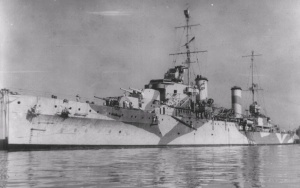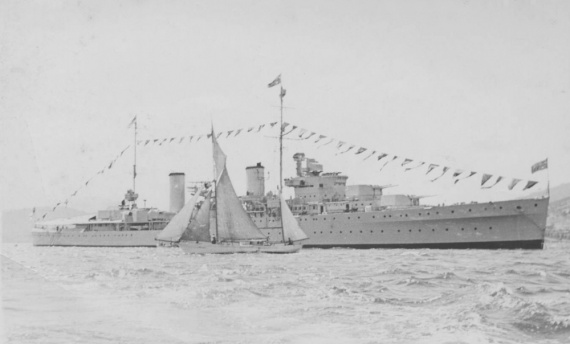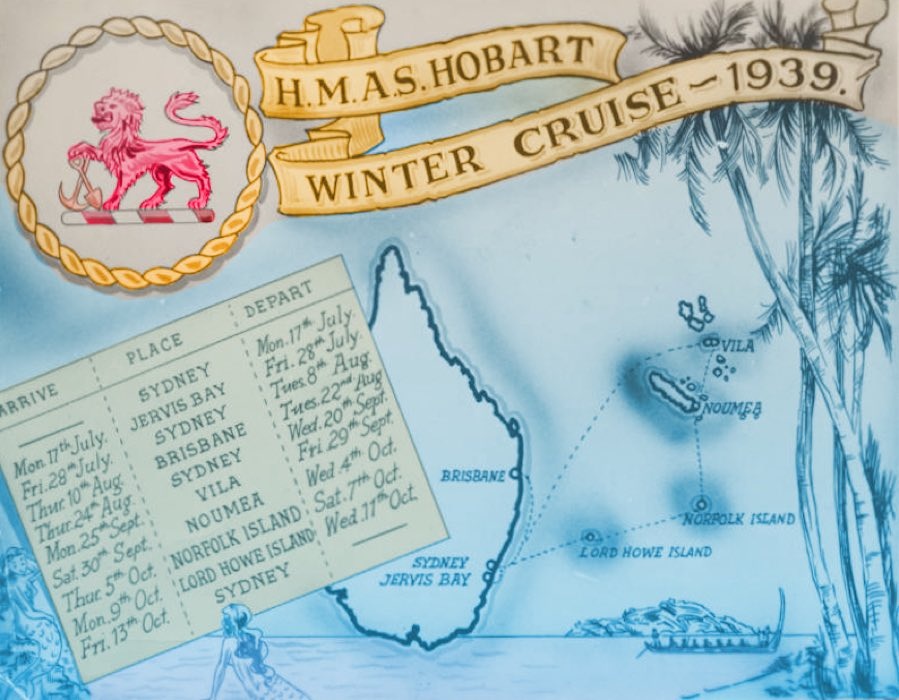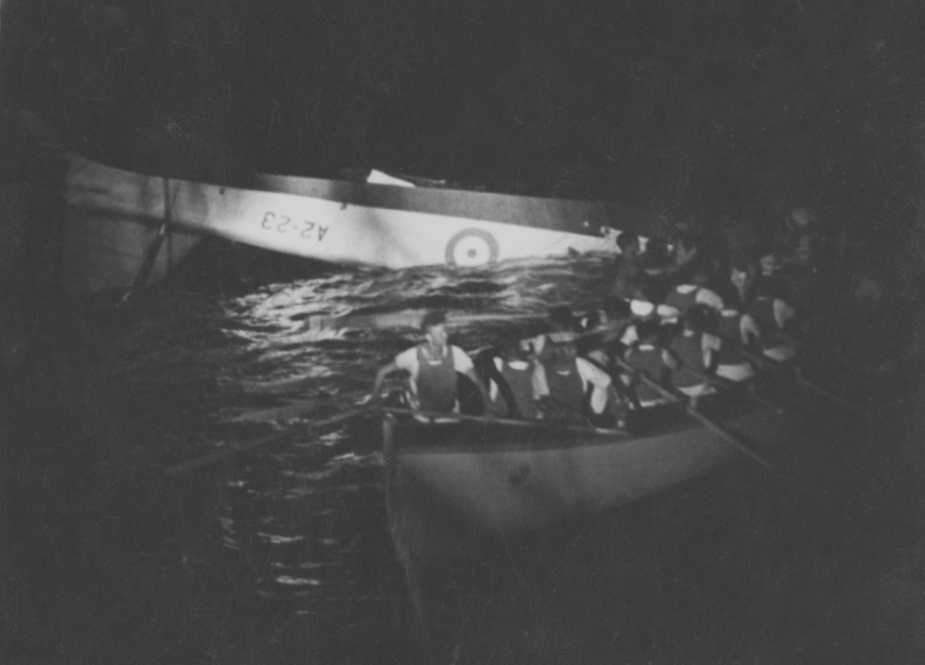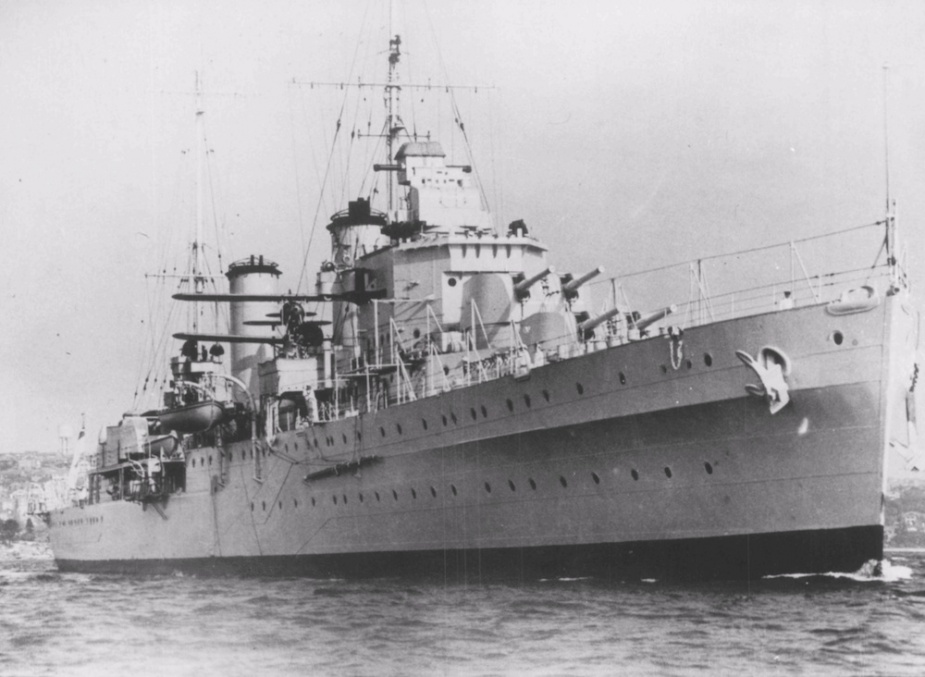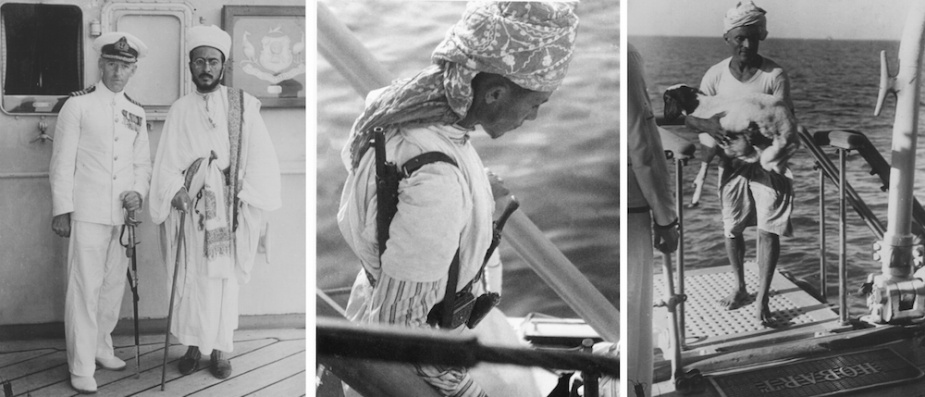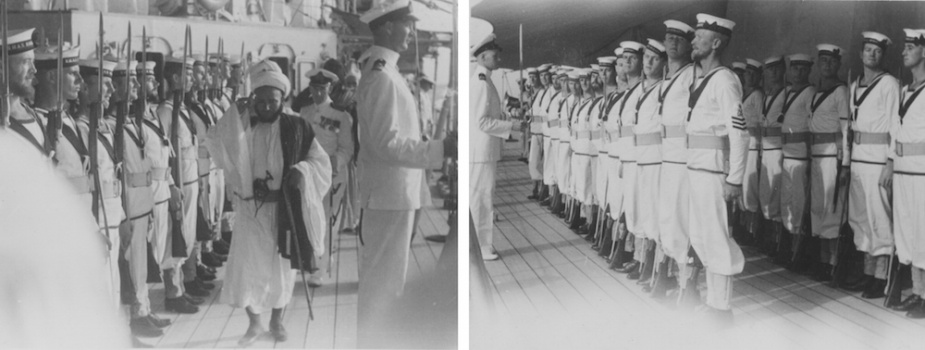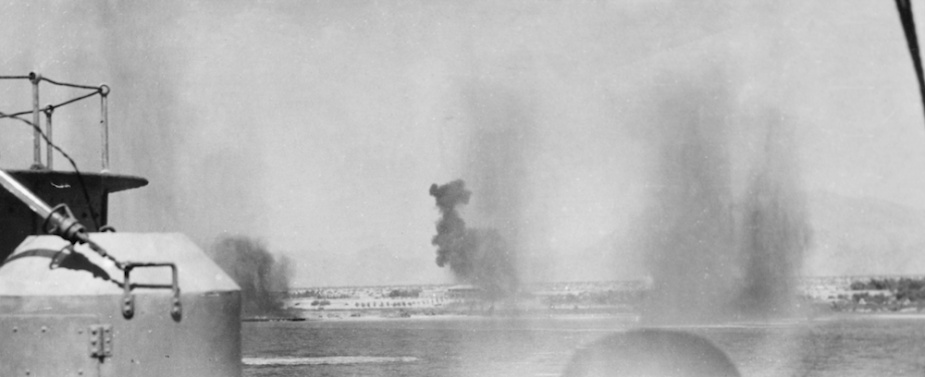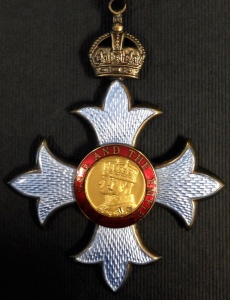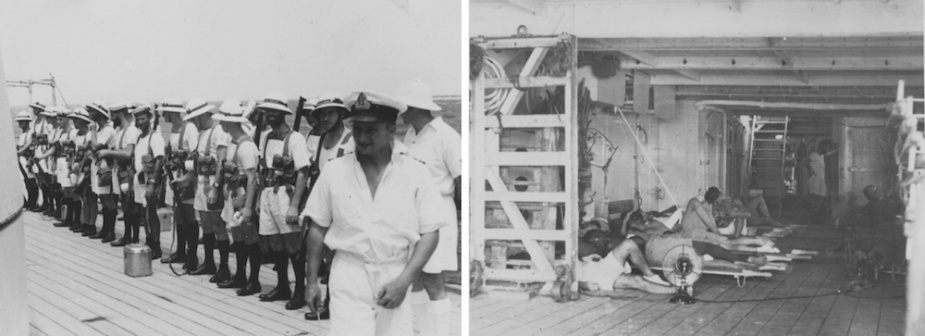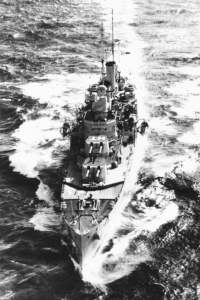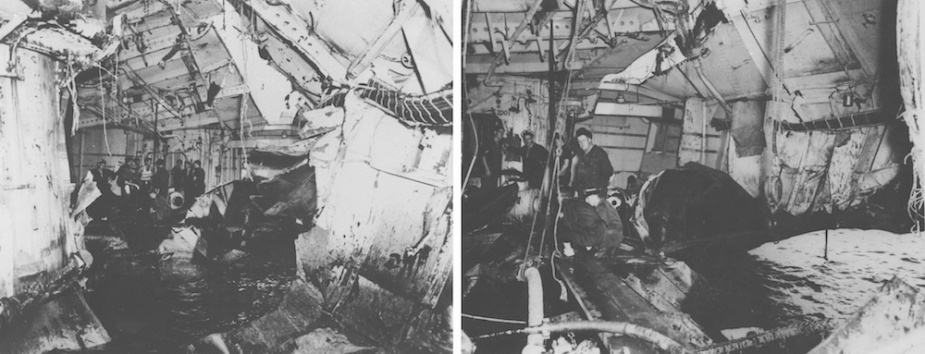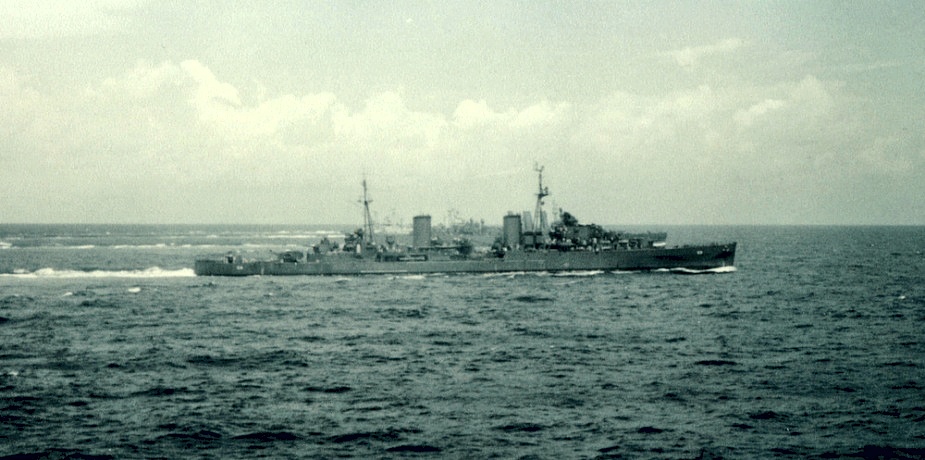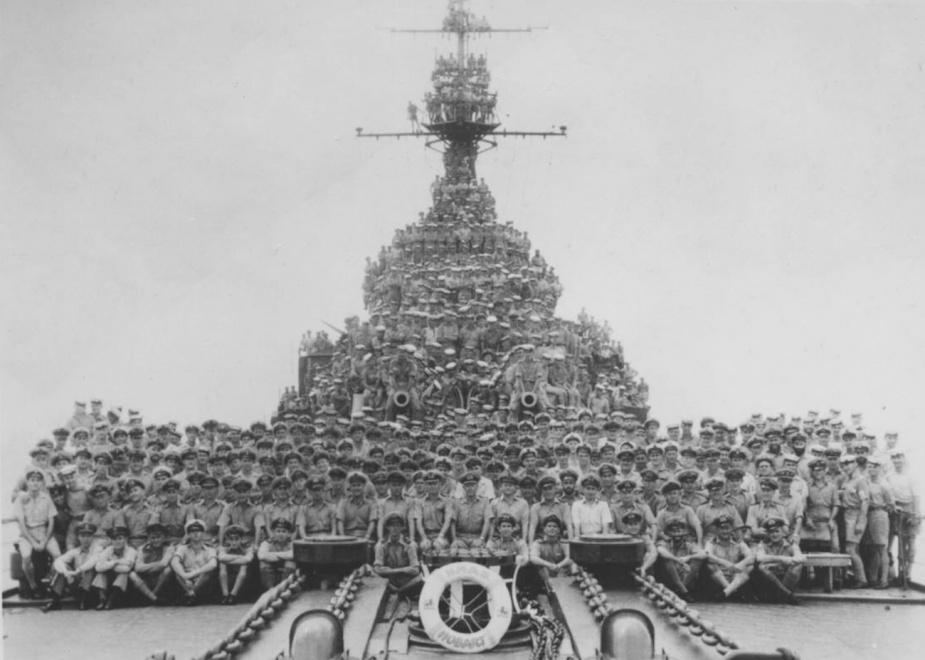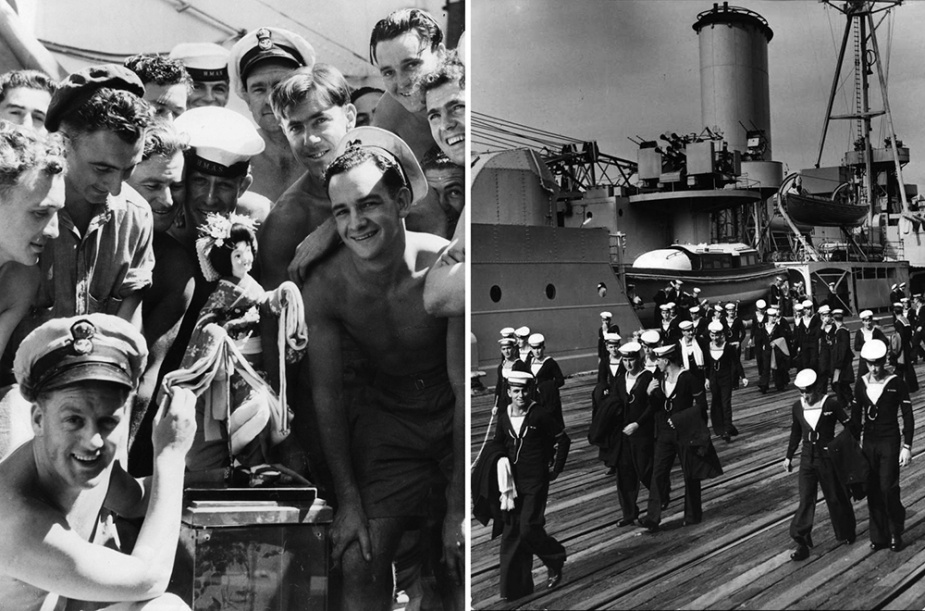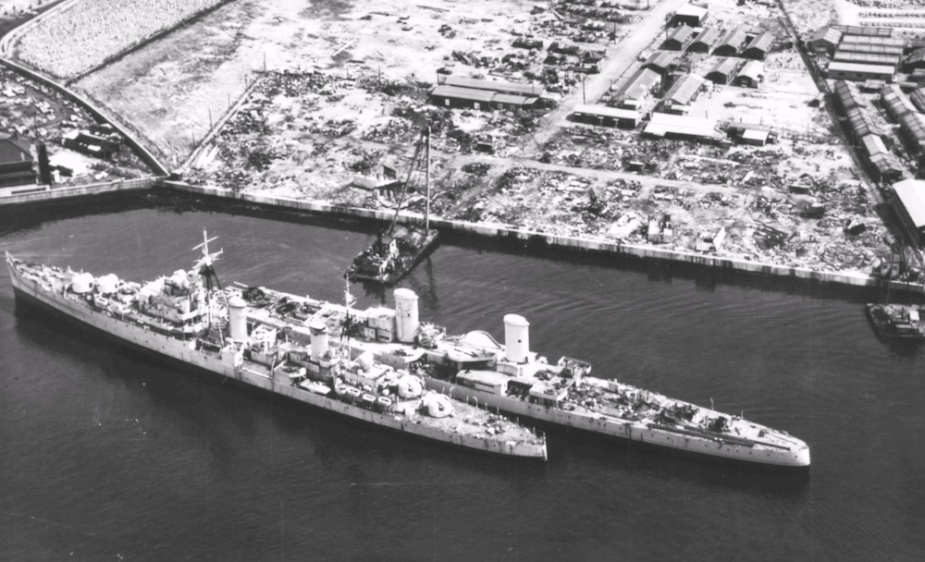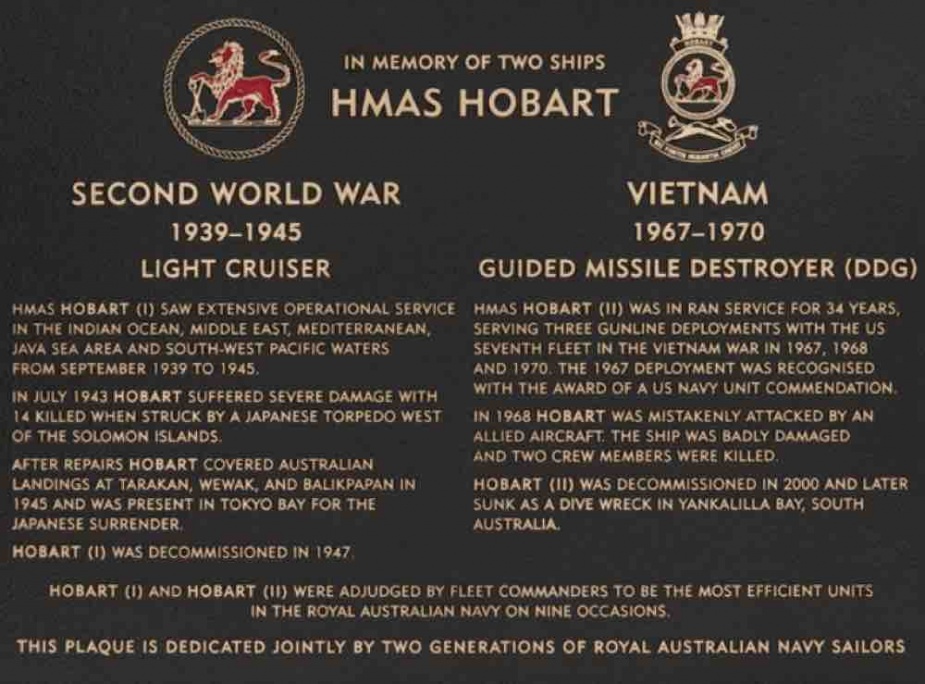HMAS Hobart (I)
| Class |
Modified Leander Class |
|---|---|
| Type |
Light Cruiser |
| Pennant |
D63 |
| Builder |
HM Dockyard, Devonport, England |
| Laid Down |
15 August 1934 |
| Launched |
9 October 1934 |
| Launched by |
Lady Florence, wife of Admiral Sir WHD Boyle |
| Commissioned |
28 September 1938 |
| Decommissioned |
20 December 1947 |
| Dimensions & Displacement | |
| Displacement | 7105 tons |
| Length | 562 feet 3 inches (overall) |
| Beam | 56 feet 8 inches |
| Draught | 15 feet 8 inches (mean) |
| Performance | |
| Speed | 32.5 knots |
| Propulsion | |
| Horsepower | 72,000 |
| Armament | |
| Guns |
|
| Torpedoes | 8 x 21-inch torpedo tubes (quadruple mounts) |
| Awards | |
| Battle Honours | |
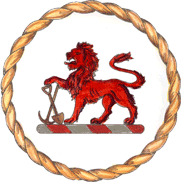
HMS Apollo and her sister ships Phaeton and Amphion were modified Leander Class light cruisers.
Apollo commissioned on 13 January 1936 and served on the North American and West Indies Station from 1936 to 1938. At Devonport on 6 October 1938, she was due to transfer to the Royal Australian Navy as HMAS Hobart but, owing to the mobilisation of the British Fleet on 28 September 1938 during the Munich Crisis she commissioned on that date under the command of Captain RR Stewart RN. She was manned by the former crew of the seaplane carrier HMAS Albatross which had transferred to the Royal Navy in part payment for Apollo. The renaming ceremony was performed by Mrs Bruce, wife of the High Commissioner for Australia in London.
Hobart sailed from Portsmouth on 28 October, one month after commissioning, and arrived in Australia at the end of 1938 in time for Christmas. On arrival Captain Stewart was interviewed by the press, remarking:
Hobart has been a really happy ship. I have been greatly impressed by the men. They are better specimens physically than the average English sailor and they are very intelligent.
On 6 February 1939 Hobart sailed from Sydney for her first port visit to her namesake city, Hobart, the capital of Tasmania. She arrived on 17 February and four days later had the distinction of fulfilling the role as the flagship of the 101st Hobart Regatta.
The next six months were spent working up and exercising off the eastern seaboard and visiting several south Pacific nations. On 28 August Captain Stewart was relieved by Captain HH Howden, OBE, RAN.
On Sunday 3 September 1939, Australia found herself at war with Germany. Hobart was on patrol in Bass Strait when news of the war reached her and she was subsequently ordered to Port Melbourne. There she undertook a series of exercises in Port Phillip before proceeding to her home port of Sydney.
On 14 October 1939 Hobart sailed for service on the East Indies Station stopping en route at Darwin and Singapore where she arrived on 26 October. Two days later she sailed and rendezvoused with the Royal Navy cruiser HMS Birmingham to patrol the west coast of Sumatra and the Sunda Strait. During this period Hobart's Walrus amphibian aircraft was used extensively for aerial reconnaissance work before meeting with accident during a night landing. The damaged aircraft was recovered with great difficulty and Hobart returned to Singapore in company with Birmingham on 5 November.
On 8 November Hobart joined the aircraft carrier HMS Eagle and the destroyer HMS Wescott as part of the escort for a west bound convoy to Colombo. On 2 December 1939 Hobart escorted the troop ship Akbar from Bombay to waters of Aden where she arrived on 6 December. There she picked up the Ettrick for the return voyage to Bombay, however, en route one of Hobart's petty officers became seriously ill requiring an urgent operation. Consequently Hobart left Ettrick and proceeded to Bombay at full speed. Notwithstanding the mercy dash Petty Officer Barker died in hospital the day after arriving.
Hobart sailed from Bombay on 10 December to escort an important convoy to Aden remaining with it until 15 December at which time she shaped a course for Colombo with orders to escort a convoy of French colonial troops through the Malacca Strait. Sailing on 23 December she spent her first Christmas of the war at sea.
On Christmas Day a festive meal was provided and the messes were decorated. Captain Howden had thoughtfully bought 100 gallons of beer in Colombo to provide Christmas cheer for his crew - this was typical of him.
1940
The ensuing months were spent escorting troop convoys in the Bay of Bengal and the Arabian Sea during which time she variously visited Colombo, Bombay, Aden, Trincomalee and Chakdina.
During this period Hobart paid courtesy visits to the Kamaran Islands, Hodeida (Yemen) and Mocha in the Red Sea. The visit to Hodeida saw Hobart anchor outside the three mile limit as Yemen was a neutral country. A 21 gun salute was fired in honour of the Prince of Yemen, Prince Seif Allslam Al Hussein, who returned the honour with a visit to the ship and gifts of goats and eggs which were carried on board by his colorful bodyguard.
Hobart was at Aden when Italy entered the war on 10 June 1940 and her first shots against an enemy were fired two days later when her anti-aircraft guns opened fire on three Italian aircraft during a raid on Aden. Seven days later Hobart returned the compliment when her Walrus aircraft was flown off, carrying out a bombing attack on the Italian wireless station on Centre Peak Island in the Red Sea. There was no opposition and the target was reported as being severely damaged.
Routine patrols and sweeps followed throughout June during which the Walrus gathered useful intelligence during a number of aerial reconnaissance flights. At the end of the month Hobart embarked officers and men of the 2nd Punjabi Regiment in Aden to convey them to Berbera, Somaliland. During the voyage there were some 1300 men on board the cruiser and her upper decks were packed with troops. The soldiers disembarked the following day.
The Allies grip on Somaliland was tenuous and the land position deteriorated rapidly following the collapse of France. With the loss of Djibouti in French Somaliland, Berbera was the only port available to the British for supplying the Allied forces ashore.
On 1 August 1940 Hobart arrived in Berbera, British Somaliland, escorting and landing further reinforcements. She remained there assisting in a general disembarkation while providing protection against any possible attack from the sea. The British however, were heavily outnumbered by three Italian columns advancing overland. On 15 August a general evacuation of the territory from Berbera was ordered.
Hobart assumed the role as the operational headquarters throughout the evacuation and alongside the crews of other ships, her personnel performed a variety of tasks. Shipwrights and joiners constructed a pontoon that complemented inadequate existing piers, one of wood and the other of stone, while her communications division provided ship to shore communications. A sea transport officer, beach and pier master were also apppointed from among her officers while ratings provided security platoons to maintain order in the town throughout the evacuation. Hobart's boats crews continuously ferried troops back and forth while others were provided as crews for the tugs Queen and Zeila.
During the evacuation, the harbour area suffered a number of enemy air attacks while Hobart's Walrus took the fight to the enemy attacking the Italian headquarters at Zeila. After the bombs had been dropped, the Walrus machine gunner, from a height of 250 feet, silenced two enemy machine gun posts, drove a lorry off the road and into a ditch and scored a number of hits on Italian staff cars.
Hobart also landed a quick-firing 3-pounder Hotchkiss gun for service with the Army as an anti-tank gun. A volunteer crew of three seamen from Hobart accompanied the gun: Petty Officer Hugh Jones, Able Seaman Jock Hurren and Able Seaman Hugh Sweeney. They later took part in fighting a rearguard action until over run. The three seamen were later reported ‘missing, believed killed’ but resurfaced unharmed when the British captured Massawa from the Italians in April 1941. All three were subsequently mentioned in dispatches.
The following honours and awards were made to HMAS Hobart (I) personnel for good services with the Somaliland Force
To be additional Commander of the Most Excellent Order of the British Empire (Military Division):
| Captain HL Howden, CBE, RAN |
To be an Officer of the Most Excellent Order of the British Empire:
| Lieutenant TK Morrison |
To be a Member of the Most Excellent Order of the British Empire:
| Mr EV Gooch, Commissioned Shipwright |
The Medal of the Order of the British Empire:
| Chief Petty Officer W Grigor |
| Chief Yeoman of Signals VM Griffiths |
| Engineroom Artificer SH Chambers |
| Sick Berth Petty Officer MHS Trulsson |
The following officers and men were mentioned in dispatches:
| Lieutenant Commander SH Crawford, RANR (S) |
| Lieutenant TM Synnot, RAN |
| Chief Shipwright A Robinson |
| Engineeroom Artificer J Gordon |
| Petty Officer H Jones |
| Petty Officer R Hancock |
| Petty Officer JH Unsworth |
| Acting Stoker Petty Officer NR Brown |
| Leading Seaman TH Spencer |
| Acting Leading Seaman AE Stripe |
| Acting Leading Seaman GH Smith |
| Acting Leading Seaman JR Drake |
| Able Seaman W Hurren |
| Able Seaman H Sweeney |
| Able Seaman RA Wood |
| Able Seaman VE Lewis |
| Signalman C Martin |
The main lift of troops took place under cover of darkness and the skill and devotion of the men engaged in ferrying the exhausted soldiers was not lost on Captain Howden who later reported:
To them, a great part of the success of the evacuation of Somaliland belongs...
On arrival at Aden later the same day the GOC Somali force and his staff were landed and all wounded were discharged ashore with the exception of two severe cases who were detained in Hobart for treatment until 22 and 26 August respectively. On 22 August an advance party of the 2nd Battalion, the Black Watch Regiment, was embarked the remaining joining the following day. Altogether some 20 officers and 661 other ranks were embarked after which the ship put to sea bound for Suez. En route a boxing match between members of Hobart’s crew and the Black Watch was held on the upper deck, which proved a distraction from the events of the previous few weeks.
Suez was reached at 07:45 on 26 August and the troops disembarked. Two days later Hobart departed Suez bound for Aden. On the morning of 30 August Hobart came under a determined aerial attack from an Italian SM81 Savoia bomber. The aircraft commenced its bombing run flying a steady course in spite of heavy anti-aircraft fire from the ship. Bombs fell nearby but none hit. Two hours later three more Italian aircraft attacked but again no hits were made.
Hobart continued escort and patrol duties as a unit of the Red Sea Force until October 1940 when it was arranged between the Commander-in-Chief East Indies and the Australian Commonwealth Naval Board that she would return to Australian waters. Following a brief refit at Colombo, Hobart reached Fremantle on 28 December 1940 and arrived back in Sydney on 3 January 1941 where she became the Flagship of Rear Admiral JG Crace, Commanding the Australian Squadron.
1941
During the first half of 1941 Hobart operated chiefly on the Australia station and in New Zealand waters visiting Auckland and Wellington on a number of occasions. At the beginning of June, the cruiser underwent a brief refit in Sydney which saw her aircraft landed and catapult machinery removed in preparation for a deployment to the Mediterranean theatre of operations to relieve HMAS Perth. On 20 June she sailed from Sydney calling at Fremantle, the Seychelles and Aden en route. She arrived at Port Tewfik, at the southern end of the Suez Canal, on 12 July where Captain Howden learned that the canal had been closed due to the presence of enemy sea mines. On the night of 14 July German bombers made a determined effort to close the canal when they attacked the port. The 28,000 ton merchant vessel Georgic, crowded with troops, was hit during the raid, catching fire. Hobart's boats were ordered away and during the hours that followed her crew went alongside the burning troopship rescuing many of those onboard. The situation worsened when the captain of Georgic attempted to beach his stricken ship, colliding with the landing ship Glenearn in the process and setting it alight. Both ships later grounded. Hobart's seamen continued to render assistance rescuing both embarked troops and the ship's crews. Dawn revealed a scene of destruction with both ships locked together on the North Shoal. Flames and smoke still gushed from he troopship although the fire in Glenearn had been extinguished. Later that day a line was passed from Hobart to Glenearn and she was towed clear.
On 15 July Hobart was led by the destroyer HMS Kipling into the Suez Canal and after a six-hour transit the three ships reached the Bitter Lakes. On 17 July Hobart berthed at Alexandria, in close proximity to her sister ship HMAS Perth.
During the next five months Hobart operated from Alexandria, Egypt, participating in the Mediterranean campaign as part of the Royal Navy’s 7th Cruiser Squadron. She routinely ferried troops to where they were most needed in support of the campaign in the Western Desert and took part in shore bombardments of both Tobruk and Bardia during October and November 1941. The cruiser was also involved in operations off Cyprus, Malta and Syria as well as participating in a number sweeps with the Royal Navy 1st Battle Squadron in company with HM Ships Queen Elizabeth, Barham and Valiant. Throughout her deployment Hobart was subjected to frequent air attacks both at sea and in Alexandria, however, her luck held and she suffered no major damage.
Hobart sailed on her last operation with the Mediterranean Fleet on 5 December 1941, in company with the Royal Navy cruisers Galatea and Carlisle and supported by five destroyers. Together they escorted the supply ship Breconshire from a position to the south of Crete, safely into Alexandria where they arrived on 7 December, the day the Japanese attacked Pearl Harbor. Shortly afterwards Hobart sailed for Fremantle calling at Aden, Colombo and Batavia en route.
1942
With the entry of Japan into the war, Hobart transferred to Far East waters becoming part of the American, British, Dutch and Australian (ABDA) forces operating in Southeast Asia. She arrived in Malayan waters in January 1942 and it was during her period in these waters that Hobart withstood some of the severest bombing of her career.
On Sunday 1 February 1942 Hobart berthed at Keppel Harbour, Singapore. By then the Japanese army had breached the causeway and a desperate rearguard action was being fought by Allied soldiers. Hobart took on ammunition and stores while her crew commandeered anything of value to deny it to the advancing enemy, this included a small 1939 Austin tourer motor car that Captain Howden brought back to Australia and which later became his pride and joy. Seven air raids were recorded during the day and a considerable number of bombs fell into the harbour. Hobart and HMS Tenedos cleared the harbour at 18:00 on 2 February and shaped a course for Tanjong Priok in the Dutch East Indies. Singapore was clearly lost and its surrender on 15 February came as no surprise. Three hours out of Singapore the ships encountered HMAS Vendetta under the tow of the destroyer Stronghold. After a long, slow tow she eventually made it back to Australia.
On 3 February 1942 Hobart and Tenedos sighted a lone merchant ship under attack from three enemy bombers. Howden ordered both ships to increase speed and close with all guns firing. The initial attack was beaten off but twenty minutes later more aircraft appeared renewing the attack with vigour. The burning merchant ship was identified as the Norah Moller, and many on board had become casualties.

